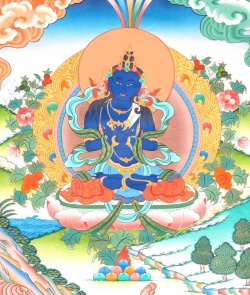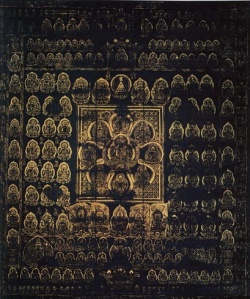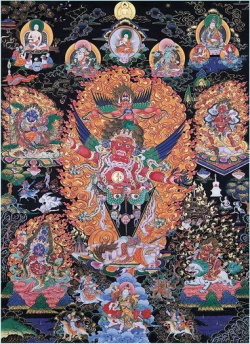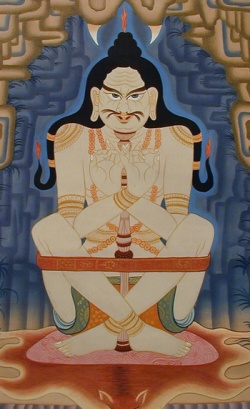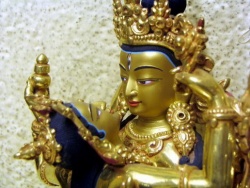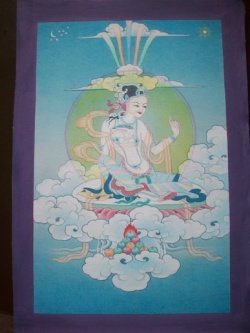Three Kayas
Khenpo Palden Sherab
translated by Khenpo Tsewang Dongyal, Rinpoches
Camp Discovery, Tennessee
12/9/89
This morning I am going to talk about the three Kayas. These three kayas are actually aspects of enlightened being. They are the Buddha reflected in three different ways in order to help sentient beings.
The meaning of the Sanskrit word Buddha is awakened or fully realized one. What is realized? The original nature is realized perfectly as it is, with nothing changed or exaggerated but as it is at both the relative and absolute levels or as relative and absolute truth. One who is awake to this understanding is a Buddha. This realization involves the complete transcendence of obscurations. We haven't fully awakened to our true nature because of these obscurations whereas Buddha Shakyamuni realized the original nature perfectly because he was purified of obscurations.
The word 'buddha' refers to all realized beings. It is not that only one particular enlightened being is known as Buddha. Those who realized their true nature in the past are known as Buddhas, those who realize it now may be called Buddhas and those who come to this realization in the future will be known as Buddhas. 'Buddha' is a general term which does not merely refer to a single individual but to every realized being.
The whole purpose of enlightened beings is to benefit sentient beings. In order to do this, they appear in many different forms or bodies. The principle emanations are known as the three kayas; Dharmakaya, Sambhogakaya and Nirmanakaya. There are even four and five kayas, divided further to qualify other manifestations of enlightened being, but it is all one Buddha. 'Kaya' is a Sanskrit word which means body in the sense of many qualities gathered together, joined and united as one. Kaya here refers to the embodiments of loving-kindness, compassion, wisdom and skillful means which appear in the world to help sentient beings.
DHARMAKAYA
The Sanskrit word 'dharma' means phenomena, both external and internal, subjective and objective. Dharmakaya refers to the primordial or true nature of phenomena which is beyond conception or dualistic thought. It is not partial. It does not discriminate. It is Great Equanimity. This embodiment of wisdom is known as Dharmakaya.
We are all aware of a great variety of phenomena. There are many things which we know and feel. However, they all can be summarized into two categories; subjective phenomena and objective phenomena. Both develop through the interaction of the elements. If we look carefully at the elements, each of them are aggregations of many sub-units. Every element is composed of individual atoms and these consist of many subatomic particles bound together as the atomic structure of that element. None of these particles are independent things. Each is dependent upon others for its existence. If we look deeply and carefully into any single element, we will find our investigation in terms of subject and object ultimately dissolves in the intuition of Great Emptiness. This is the ultimate examination we can make. To go further is beyond our dualistic conceptions. Understand the real nature of the external world to be no other than Great Emptiness.
If we look at subjective phenomena, we find that it is similar to the elements. Mind can be conceptually divided into eight categories or many more but it functions as a single aggregate. If we search for where our present thought comes from, we will not find an exact source. If we look to where it goes, we cannot know it's destination. We cannot even find the spot where it exists. In this way, we can see that mind, the subject, is arising in Great Emptiness, inexpressible by mundane conceptions or speech.
Both the internal and external are based in one primordial nature. Outer or inner, there is no distinction, all are one Emptiness beyond dualistic thought, beyond existence and non-existence, both and neither. It goes far beyond the conventional notion of emptiness or vacuity. It is not some 'thing' to which we can cling. It is always here, never increasing or decreasing, but remaining as it is, as it was and how it will be all the time. Circumstances cannot change the primordial nature. Perfect realization of this nature is realization of Dharmakaya.
SAMBHOGAKAYA
Great Emptiness is our primordial nature. This Emptiness is not like a black hole or a state of nothingness. Emptiness is more like a state of fullness. By means of the primordial nature, everything is arising without effort, without thought, spontaneously appearing with clarity. That is the sign of Emptiness. If there were no Emptiness or primordial truth, everything would be blocked, nothing could move, nothing could develop and nothing could manifest. This spontaneous radiance of unceasing clarity is the meaning of the Sanskrit term, 'Sambhogakaya' .
'Sam' means perfect, 'bhoga' means enjoyment and kaya is roughly translated as body. Thus, 'the body of perfect enjoyment' is the radiant wisdom aspect of our original nature. The Sambhogakaya is displayed as the Five Wisdoms. The first of these is Dharmadhatu Wisdom. The second is known as Mirror-like Wisdom. The third is the Wisdom of Equality. The fourth is Discriminating Awareness Wisdom. The fifth is known as All-Accomplishing Wisdom. These Five Wisdoms are the clarity aspect of our true nature.
While we are in the world of samsara or as long as we are not realized, these wisdoms are known as the eight consciousnesses. When you purify the obscurations, these eight are transformed into the Five Wisdoms. Therefore, the nature of our present consciousness is based upon these Five Wisdoms.
THE EIGHT CONSCIOUSNESSES
I will name the eight consciousnesses for people who don't know them. The first five are the eye consciousness, ear consciousness, tongue, nose and body consciousness. These five consciousnesses function through the organs to perceive the five external objects of sense. In themselves, these five are very partial and limited. The eye consciousness is only for form. It cannot taste or hear sounds or smell. Similarly, the ear is only for sound, not for seeing, tasting and so forth. Now how can these scattered consciousnesses be brought together into one united state? That is the function of the sixth consciousness which is like the driver or a judge who makes decisions. It receives and organizes the input of the five external consciousnesses and gives meaning to our experience. The sixth combines and integrates the sense consciousnesses into one. It is known as mind consciousness.
The first five consciousnesses are very immediate. They have no continuity. They only refer to the present. They cannot sense the past or the future. They only communicate directly with the present. They are very exclusive and one-sided. The sixth consciousness not only unites these five, it can also refer to the events and activities of the past and future. It is actually structuring our sense of time.
A closer look reveals that the mind has two sides. One, which we have called the sixth consciousness, is dealing with the business of the past, present and future; making decisions based on the information received from the first five consciousnesses. It is very neutral and rational. There is another side to this mind, the seventh consciousness, which is basically very emotional and gives rise to ego-clinging. On the basis of ego-clinging, ignorance, anger, attachment, jealousy, pride and doubt develop. All this arises in that singular aggregate we call the mind.
All seven of these minds are based upon an eighth consciousness which is known a 'kun-gzhi' in Tibetan, the ground of mind. It is sometimes translated as 'subconscious storehouse'. In Sanskrit, it is called 'alaya'. The nature of the eighth consciousness is neither positive nor negative; it is neutral. Alaya retains every basic habit-pattern of individuals. Everything is stored there; our good karma, bad karma, and neutral karma. All kinds of habits and whatever actions we perform during our lifetimes are registered there. This is why it is known as a 'storehouse'. Alaya is a consciousness, but it is very subtle.
When these eight consciousnesses are transmuted or transformed, they become the Five Wisdoms. The Five Wisdoms are symbolized by the five Dhyani Buddhas. They are the radiant spectrum of clarity qualifying the Dharmakaya. The central Buddha of Dharmadhatu Wisdom is Vairocana. The eastern Buddha of Mirrorlike Wisdom is Akshobya. The Wisdom of Equality is embodied in the Buddha of the southern direction, Ratnasambhava or Rinchen Jungnay in Tibetan. The western Buddha of Discriminating Awareness Wisdom is Amitabha or Opagme in Tibetan and the northern Buddha of All Accomplishing Wisdom is known as Amogha Siddhi. These are the principle Buddhas of the Sambhogakaya.
NIRMANAKAYA
All Buddhas are emanations of one Buddha. The different levels, aspects or kayas of Buddha exist only for the purpose of benefiting sentient beings. Each Buddha can appear in any of these three kayas. Dharmakaya Buddhas such as Samantabhadra appear only to highly realized beings, such as tenth bhumi Bodhisattvas who can also receive teachings from the five Dhyani Buddhas. Beginning practitioners, or those with dualistic thoughts and conceptions, would have difficulty perceiving and receiving teachings from Sambhogakaya and Dharmakaya Buddhas.
The third Buddha, is known as the Nirmanakaya Buddha. Nirmana is a Sanskrit term which means manifest in form. Not just in one style or form but in all kinds of ways, in order to benefit all sentient beings whether they are highly realized, beginners or even heavily obscured. The Nirmanakaya Buddha is for everyone. The Nirmanakaya can be divided into four groups:
1. Supreme emanations
2. Birth emanations
3. Artisan emanations
4. Emanations of various things
The Supreme emanation takes birth in the world as a unique person. Buddha Shakyamuni and Guru Padmasambhava are examples of this kind. They have special forms of body, speech and mind. The special qualities of the body are known as the thirty-two major marks and the eighty minor marks. For instance, their bodies have a radiant glow and are free from old age and sickness. They also have a subtle blue light called akanistha going up from the crown chakra and merging into the sky as well as special patterns of the wheel of Dharma on their palms.
They have sixty qualities of speech which most people do not have. For example, when Buddha gave teachings, as soon as his voice was heard, it would give a soothing, relaxed, peaceful feeling. At the same time, whatever words he spoke could be heard at once in many different languages. Students from other lands would hear the Buddha's voice in their native tongues. Also, his speech was not affected by distance. An audience of hundreds or thousands had no problem hearing even though they were very far away. Buddha's voice could reach to ten thousand students as clearly as to those sitting right in front of him.
The mind of realization has the three qualities of love, compassion and wisdom, as well as the ten powers and eight kinds of fearlessness. Altogether there are thirty-two qualities of mind. A Buddha has no obstruction to seeing the past, present or future. Everything is clear to the eye of wisdom. A Buddha's speech and body qualities are somewhat more obvious, but many people doubt such wisdom. They think it cannot be exactly as it says in the sutras. Even in Shakyamuni Buddha's time they investigated this. They closely examined whether Buddha was totally enlightened and perfectly clear in relation to objects or not.
Buddha renounced his father's kingdom and went to the jungle where he did six years of ascetic practice. Upon becoming enlightened, he turned the wheel of the Dharma many times for many students and so became very famous in India. After awhile, his family invited him to come back to his homeland to teach. Buddha said he would not come to the palace, but that he would stay outside the main city. So the Buddha's father and a local ruler named Zangdon who was under his dominion, had a special retreat built for the Buddha and his students. Buddha came and stayed there and began giving regular teachings.
Buddha was already known as 'The Omniscient One', being knowledgeable about every aspect of the past, present and future. But King Zangdon had his doubts about that. In order to test him, Zangdon collected one grain of rice from each of two thousand five hundred families. Each grain was wrapped individually, numbered and put into a common basket which was brought before the Buddha. King Zangdon wanted to see if the Buddha could tell him which grain came from which family So one by one, the Buddha examined the grains and told him which households they had come from. The king observed his list of numbers and names and saw that the Buddha's answers were all correct. There were no mistakes. He bowed respectfully to the Buddha and declared, "Now, I know you are omniscient. You are obviously enlightened." Finally, Zangdon became very devoted. This is just an example of the qualities of the mind of a supreme emanation.
The second Nirmanakaya or birth emanation incarnates even in the animal and non-visible realms, using different names and forms, male or female as they are needed. There are many Jataka stories of Buddha taking birth in animal worlds as a fish, a turtle, a bird, a monkey, a bear and a lion, as well as among humans and even in the god realms. These are all birth emanations or tulkus. They may or may not appear in the traditional way, wearing robes and all. Tulkus may not even necessarily be recognized as Buddhas but in every case, they are born to remove obstacles and dualistic conceptions, to free sentient beings from ignorance and bring about the perfect understanding of primordial wisdom.
The third Nirmanakaya is called the artisan emanation. These appear as objects of art and the artists who make them for the benefit of sentient beings. Thangkas, statues and even music are some of the forms these emanations take. Beautiful, inspired works of art which bring clarity, peace, joy and something special which seems to touch the heart center, are all known as artisan emanations.
There was a famous musician called Rlanga who felt that he was the supreme guitarist. And he was a very special musician, but he was also proud and arrogant. He thought he was incomparable to anybody in the world. He was always playing his music and never had any opportunity to see Buddha or receive teachings. He appreciated the Dharma but he was attached to playing music and felt he should spend his time practicing. He really thought he was the greatest.
Rlanga heard the Buddha was going to enter Mahaparinirvana and thought that he should visit him soon to receive teachings and have some contact. But he was still very involved in music and maintaining his pride. So right before he entered Mahaparinirvana, the Buddha thought, "Now what is it I still have to give sentient beings with this body? Who may I serve? Who is left?" Through his wisdom he saw Rlanga in his present condition. So Buddha emanated one very special musician and went to the door of Rlanga with a thousand-stringed mandolin. When Buddha started to play and the famous musician heard that music, he began to listen closely and thought, "Who could that be?" He had to come outside and bring his mandolin. Soon, he noticed Buddha hardly even moved his fingers. Plucking one string resonated all the others. Rlanga was unable to do this. The vibration of the music seemed to separate out the whole of space into many different voices of the Dharma which were of real benefit to this famous musician. He thought, "So there is someone more accomplished than myself! I am not the best..." At that moment his arrogance and pride dissolved. He felt very grateful to hear the Dharma through that mandolin.
Any kind of art which provides temporary or ultimate help for sentient beings by awakening love and compassion is known as an artisan emanation.
The emanations of various things manifest in a variety of ways. These can appear as rain, fire or wind. During times when sentient beings are troubled with diseases, they may come in the form of special herbs and medicines for healing or perhaps when beings are in danger of losing their lives, suddenly something miraculous occurs and saves them. All of these things are various forms of the Nirmanakaya.
There is really just one Buddha. Every person who becomes enlightened has the ability to transform or emanate in these three kaya states. So basically again, Buddha means one who has fully developed love, compassion, wisdom and skillful means, one whose obscurations and habit patterns have been purified, one who has realized a totally free, devotional state. That sentient being, that person, that individual is known as an enlightened being or a Buddha.
This is the teaching of the Three Kayas.
